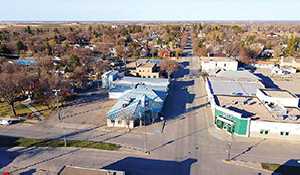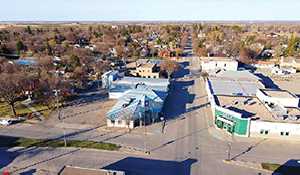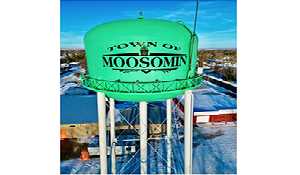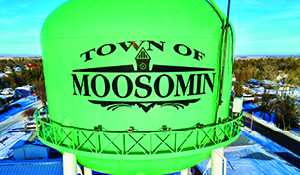Meetings next Tuesday for assisted living plan
New facility eyed for Moosomin
January 11, 2021, 8:01 am
Rob Paul, Local Journalism Initiative Reporter
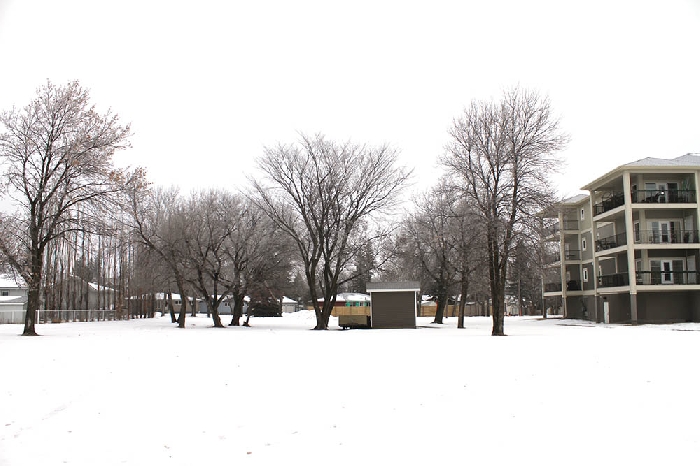

Meetings are coming up Tuesday, January 19 for a 42-unit assisted living facility proposed for Moosomin, to determine investor interest.
The building would have 14 long term care beds on the main floor, and 28 assisted living units on the second and third floors.
The facility would be next to Pipestone Villas on Wright Road. The plan is to offer the meals, wellness checks, and housekeeping not only in the new facility but also to Pipestone Villa residents if they want them, so that the services would be available to 100 units in total.
The facility would create 15 full-time equivalent positions including—there will be more than 15 people employed as some positions will be part-time.
The proposal has been put together by Manitoba-based Bridge Road Developments—which developed the original Pipestone Villas in Moosomin and properties in many other communities.
The project proponents plan to meet with Pipestone Villas shareholders on Monday, January 18, and invite members of the public who would potentially be interested in investing in the project to meetings on Tuesday, January 19.
“We see real potential for this,” Travis Penner of Bridge Road said.
“We’re here as a developer, general contractor and investor. We certainly intend on investing in the project as well.”
“The goal of the project is to keep as many people who require a higher level of care in Moosomin as possible,” said Heather Haupstein of Care by Design, which is involved in the project.
“With this new project, we want to include the residents in Phase 1 and 2 as much as possible, and have a sense of community.”
Larry Scammell of Kohr Capital said the proposal is to handle investments in the facility through a mutual fund trust, which would allow investors to purchase shares within RRSPs, TFSAs, RRIFs, and LIRAs.
The project will need $3 million of investor funds to proceed.
Scammel said ideally he would like to see all the funds raised locally. “In a perfect world we would get 100 per cent of the investment locally, but if that can’t be done we can backfill it with investment from outside the community,” he said. “Community investment, community ownership is very important, and we would tip our hat to what has been accomplished by Bridge Road in this community and others.”
Penner said the project could move ahead quickly once funds are in place. “It would be five to six months from starting the plans to getting shovels in the ground, and a 12-14 month window from when shovels get into the ground to project completion.”
The investor meetings January 19 are set for 10 am, 12:30 pm, and 6 pm
People must pre-register to attend the meetings. Anyone interested in attending can contact Moosomin Economic Development Officer Greg Gillespie at 306-532-3157 or email moosominedo@sasktel.net
Q&A on the project
Kevin Weedmark spoke with Travis Penner, vice-president of Bridge Road Developments, about the plan for an Assisted Living/Long-Term Care facility in Moosomin. Investor meetings are coming up January 19. The complete interview follows:
Can you walk us through and tell us how this proposal came together and why this is being proposed for Moosomin?
It really dates back a few years. It stemmed from the Pipestone Villas Group. They’ve been instrumental in providing the independent living facility for seniors in Moosomin and surrounding area.
The Pipestone Villas proposal back in 2010 initially proposed that we would do three phases, and mapped them out. As we built phase one and phase two of Pipestone Villas we’ve evaluated do we build another phase just like Pipestone Villas or have we met the majority of the demand for seniors independent living right now?
There have been discussions with the Pipestone group and the consensus is, there may not be enough sustained demand for 72 suites of independent living, which is what you would have with three phases, but there’s an increasing demand in a newer building with services—with food service and providing care.
The conception of a third phase that included services happened two or three years ago.
It’s been a slow progression of evaluating the market and determining that, yes, this is what we want to do. Then it was a matter of, who is going to provide the care. Ultimately, any building like this is only successful with a good operator. You want your residents taken care of and left in good hands. So, both from a tenant perspective, as well as an investor perspective, that operator is key.
The last 12 to 18 months has essentially been an evaluation of operators. There was a presentation done 15 months ago, 16 months ago, with Orange Tree, and that further demonstrated demand that the response to those meetings was greater than anticipated by all parties. That really enforced that yes, this is the right direction to go. After further discussion, it just didn’t work out with Orange Tree and we engaged new discussions with Heather and Jim Haupstein from Care by Design and they have a long history of running successful businesses, care home businesses both large and small. And there’s a great comfort level dealing with them.
And the idea is they will come up with the plan for the care side and do the training of staff initially? Then the new company will actually operate it?
Absolutely. Heather and Jim will be involved extensively in the design, they’ll be involved extensively in the training and hiring, and setup of procedures and policies and in the initial startup of the building. They’ll be on-site for the first three to six months until the building is running smooth and providing the training for the permanent manager that’s going to run the facility. And then on an on-going basis, they’ll be involved in a consulting role. They will be a resource to our on-site manager. If there are problems, Jim and Heather will become involved remotely by phone and email but then also in person if required as well.
What sort of services will be provided—I believe it’s assisted living in 28 suites on the top floors and 14 beds of long-term care on the main floor?
That’s exactly it, long-term care on the first floor and assisted living on the second and third floors, with the ability to provide different levels of care on those two assisted living floors.
Long-term care would be your level three/four tenants with health care requirements. Floors two and three, that we’re terming as assisted living, would be your level one/two.
The level one/two would essentially require the meal programs, some light housekeeping and maybe some light medical care with a little bit of help with medications possibly, but not necessarily.
With the staff that we’ll have on hand, that are trained to provide care for the long-term care residents, we will have the ability to provide some additional services. And again, whether that’s medical requirements or getting dressed or any of those sorts of things, we will be able to provide services on those top two floors as well.
And some of those may be available to people in Pipestone Villas as well?
Absolutely. How that rolls out hasn’t yet been defined. We have to determine the demand from the existing Pipestone tenants but that’s absolutely the desire, to provide service for those 48 suites as well as the 42 new units.
Is this a first for Bridge Road or have you been involved with assisted living or long-term care in other facilities?
We have been involved in a few care homes, they would be smaller in size than what is proposed for Moosomin. We’ve been involved in a dementia wing and in three other care homes, but the largest of those would have been 20 suites. So this certainly would be larger than the ones we’ve done in the past, but we’ve been involved in four projects that would involve a level of care from a construction and development perspective.
How different is it going into a project like this compared to the traditional independent living projects that you folks have been involved in?
From our perspective, the marketing end becomes a little different. You’re marketing to a different demographic. From a construction perspective, construction is construction. Certainly there are different code requirements for our architects and engineers, but the real key difference is what you’re looking for in an operator. For our independent living buildings, such as Pipestone, you’re looking for a property manager, but that property manager isn’t necessarily dealing with any health care needs, or services such as food services and housekeeping. They certainly are dealing with maintenance and rent collection, and there are certain skill sets required there. It’s a very different operation, it becomes more of an active business than it does a passive business when you’re involved in the building with care. The biggest difference is finding that right operator, to make sure the active business keeps moving.
There are investor information meetings coming up on January 19. For this project to go ahead, how important is it to get a good turnout there and to see some interest there?
It’s vital. This is a project that’s been in the works for a couple of years. Before this project can really start to gain traction and move forward, we need investors.
We have an operator that we are very confident in. We are confident in the market and the demand that will be there. Now it’s a matter of, what sort of support is there from the community to invest in this project and get this project off the ground?
If we were to look at beginning construction this year, we need to have our investor funds in place sometime in early spring. Getting that significant turnout now is vital in getting momentum and raising those investor funds.
What’s the total budget for this project and how much are you hoping to raise from local investors?
The total budget is approximately $7.5 million and we’re looking to raise approximately $3 million.
The rest will be financed by a financial institution. The ideal scenario would be the vast majority of that $3 million would be raised locally in the community, but certainly if there isn’t enough support there we will look to branch outside of the community to put the required investment funds in place.
Is this something people need to have pretty deep pockets to invest in or is this something that’s going to be available to your typical retail investor?
There are a couple of different vehicles, and we’re going to get into a lot more detail with those vehicles in the presentation, but there’s the opportunity to invest directly into the project which will require a larger investment, and the opportunity to invest through a mutual fund trust which opens the door to people to invest with registered funds such as RRSPs and TFSAs. An investor can roll in existing RRSP or TFSA funds they have now. As far as the levels of investment and what those vehicles look like, we are going to get into a lot more detail in the presentation.
If you do get a good buy in from investors, what kind of timeline are you looking at for this project?
We have the conceptual design. If we can get our investor funds in place by early spring, we would then begin work with the consultants, architects and the engineers and we would envision a 12 to 16 week process of design followed by another four to six week process of permitting and tendering and then construction would begin. You’re looking at roughly five to six months from when we give the consultants the green light to when construction can begin. It would be a late summer, early fall construction start, provided investor funds are in place in early spring.
How confident are you that you are going to get that investor support in this project and go ahead?
We feel confident. The meetings we held 16 months ago certainly demonstrated interest from a tenant perspective but it also demonstrated interest from the local business community. We’re confident that this project will move forward. The community has been extremely supportive as we look at the last two phases of Pipestone Villas and we’re confident that the community sees this need and has a desire to have this type of facility in the community and that they’ll support it.
Do you think there is an unmet need out there in a lot of rural communities for this type of facility?
Absolutely. The Bridge Road model of independent living was born out of recognizing the need for a building like that, for those that want to move off the farm or move out of their house and have the freedom to go south in the winter or travel and do whatever and live a maintenance free lifestyle.
As we’ve went across the communities in Manitoba and Saskatchewan we recognized there was this need. People were moving to the larger centers because there was nothing in town, or what was in town was perhaps quite an aged inventory and not meeting the desires for size and amenities that this generation was looking for. Over the years, as we’ve continued to build those, we recognized not only is there a need for that but there is a need for something with care provided, and something with services. Again, there are a lot of rural communities where there is some fairly old and dated inventory.
Beyond that, there is just an increasing level of desire for something newer, nicer, perhaps bigger than what was available. Again, we were recognizing that in a lot of communities. Even if there was inventory, there was a shortage and people were still being forced to move to larger centers or Regina, or Saskatoon, or Moose Jaw or PA, wherever the largest centers were.
We have a vision of trying to serve the rural communities, both in independent living but also with care. Allowing people to age in place, rather than being removed from the community that they’ve grown up in and the only community they’ve known for most of their lives.
Anyone interested in attending the investor information meetings can contact Moosomin Economic Development Officer Greg Gillespie at 306-532-3157 or email moosominedo@sasktel.net

















